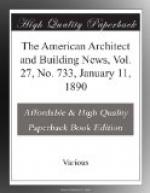Some textile mills have been built in the form of the block letter U, this form having been decided upon as giving the conditions of lowest resultant cost. One wing, two stories in height, contains weaving; the other wing, three stories in height, contains carding and spinning, while the engine is placed in the connecting building. The pickers and the boilers are in outside buildings, so placed that they will not interfere with future extensions of the building into the form of the block letter H.
FIRE APPARATUS.
All methods for the prevention of fires fall so far short of the ideal of immunity that there is a necessity for fire-apparatus. The principle of the defence of a manufactory against fire is that of self-protection, by making the installation and management of the fire-apparatus equal to the progress of any fire which can possibly occur.
Fire-apparatus should be kept in service as well as in order. It is no exception to any other machinery, in that practice is essential to obtain any efficient results.
The practical results of private fire-organizations, where fire has occurred, have been very marked; and systematic and skilful work has been the rule, in place of the needless confusion and liability to breakage of the apparatus, which almost inevitably occurs in the lack of such organization.
The details differ with the arrangements and administration of every mill; but the general policy of definitely assigning persons to the positions for which they are best adapted, and where it is presumed they could be most useful, and to practice them in such work, is a rule which is common to all.
A great deal of fire-apparatus is destroyed by freezing water during the winter months, and therefore a special inspection of all such apparatus should be made late in the autumn, when the water should be drained from all portions of the system where there is liability of freezing, and all hydrants and valves should be well oiled, preferably with mineral oil. The hazard from a hydrant or other portion of the apparatus broken by frost, does not lie so much in the probability that disadvantage may result from the disuse of one element of the plant, as in the liability that such a breakage may interfere with the whole system and render it inoperative.
Buckets of water are the most effective fire-apparatus. They should be kept full, and distributed in liberal profusion in the various rooms of a mill, being placed on shelves or hung on hooks, as circumstances may require. In order to assist in keeping them for fire purposes only, they should be unlike other pails used about the premises, and in some instances each pail and the wall or column behind its position bears the same number.




